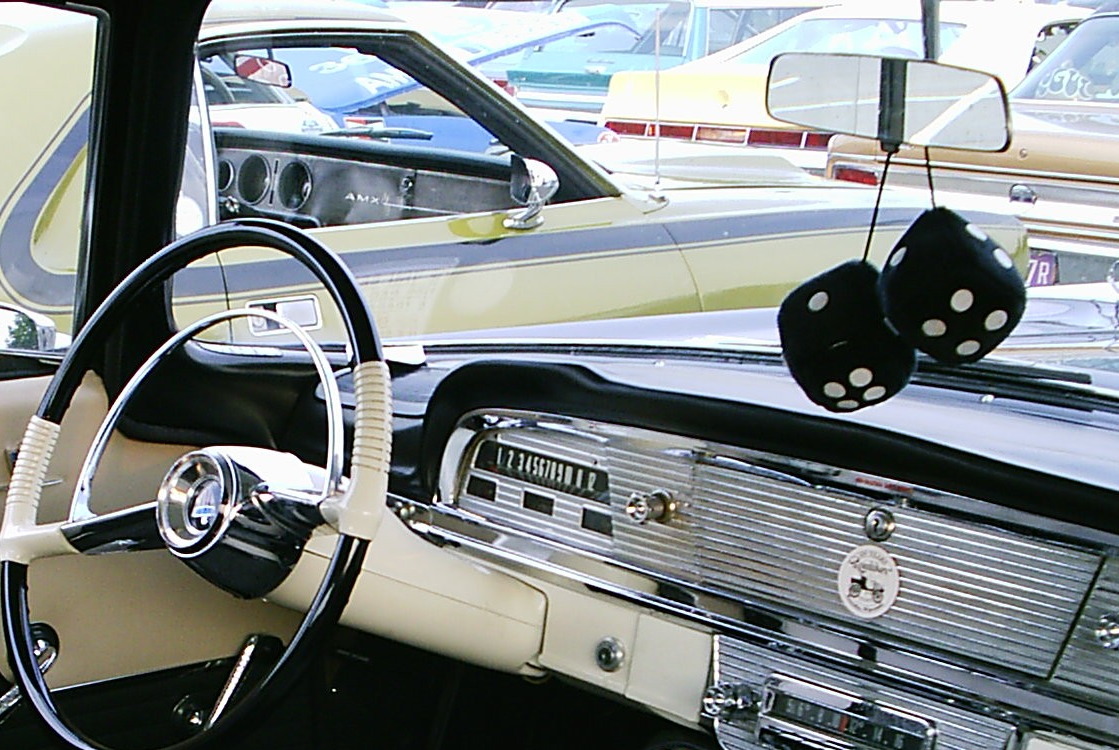Fuzzy dice on:
[Wikipedia]
[Google]
[Amazon]

 Fuzzy dice, also known as fluffy dice, soft dice, or stuffed dice, are an automotive decoration consisting of two oversized (usually six-sided)
Fuzzy dice, also known as fluffy dice, soft dice, or stuffed dice, are an automotive decoration consisting of two oversized (usually six-sided)
 Fuzzy dice, also known as fluffy dice, soft dice, or stuffed dice, are an automotive decoration consisting of two oversized (usually six-sided)
Fuzzy dice, also known as fluffy dice, soft dice, or stuffed dice, are an automotive decoration consisting of two oversized (usually six-sided) plush
Plush (from French language, French ) is a textile having a cut nap (textile), nap or pile (textile), pile the same as fustian or velvet. Its softness of feel gave rise to the adjective "plush" to describe something soft or luxurious, which was e ...
dice
Dice (singular die or dice) are small, throwable objects with marked sides that can rest in multiple positions. They are used for generating random values, commonly as part of tabletop games, including dice games, board games, role-playing g ...
which hang from the rear-view mirror
A rear-view mirror (or rearview mirror) is a flat mirror in automobiles and other vehicles, designed to allow the driver to see rearward through the vehicle's rear window (rear windshield).
In cars, the rear-view mirror is usually affixed to ...
. The original fuzzy dice, first used in the 1950s, were white and approximately across. Nowadays, fuzzy dice come in many colors and various sizes. In Britain and other parts of the world it is considered kitsch
Kitsch ( ; loanword from German) is a term applied to art and design that is perceived as naïve imitation, overly-eccentric, gratuitous, or of banal taste.
The avant-garde opposed kitsch as melodramatic and superficial affiliation with ...
to display such items in a car.
Origin and history
The use of fuzzy dice is believed to be traced back to American fighter pilots during World War II. Pilots would hang the dice above their instruments displaying seven pips before a 'sortie' mission for good luck. It is also speculated that the dice represented a high degree of risk associated with the fighter sorties; hundreds of pilots were shot down each week. Upon returning after the war, many airmen continued the tradition. In the 1950s, the fuzzy dice became one of the first items sold specifically to be hung from a rear-view mirror. The ''Encyclopedia of American Social History'' notes that during the 1950s, young adults were drawn to cars that were "customized for speed, painted with vivid colors, stripes, and flames, tuck-and-roll interiors, fuzzy dice suspended from the mirror, rock-and-roll on the radio...". Another explanation for hanging these in a car has been proposed that "displaying the dice meant the driver was ready and willing to be 'dicing with death' in the dangerous and unregulated world of street racing". In some segments, such as thelowrider
A lowrider or low rider is a customized car with a lowered body. These customized vehicles are generally individually painted with intricate, colorful designs, rolling on wire-spoke wheels with whitewall tires. Lowrider rims are generally smalle ...
community, research indicated that even the most dedicated individuals "did not attach any significance to the dice" that was hung from their car's rearview mirror.
A 1993 study found no correlation between the use of fuzzy dice and the degree of a driver's reckless driving behavior.
In some jurisdictions, suspending objects from rear-view mirrors
A rear-view mirror (or rearview mirror) is a flat mirror in automobiles and other vehicles, designed to allow the driver to see rearward through the vehicle's rear window (rear windshield).
In cars, the rear-view mirror is usually affixed to ...
is illegal.
A technology upgrade to the product includes illuminated LED plastic dice that change colors.
See also
*Effects of the car on societies
Since the start of the twentieth century, the role of cars has become highly important, though controversial. They are used throughout the world and have become the most popular mode of transport in many of the more developed country, developed ...
References
External links
{{commons inline, Fuzzy dice Automotive accessories Dice